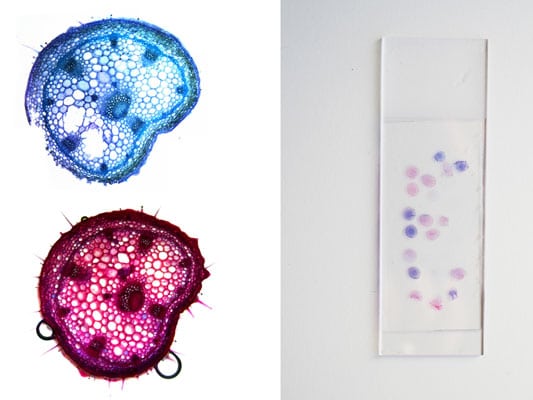ANDREW JOHN MILNE & CHANTAL DUPAS (Winnipeg, MB) | OMMATIDIA MURALIS
March 10 – April 16, 2016
Opening Night: Thursday, March 10
Artist talk at 7:30PM | Reception to follow
The ODD Gallery is pleased to present Ommatidia Muralis, a new collaborative interactive installation by Winnipeg artists Chantal Dupas and Andrew John Milne.
As artist-in-residence at the University of Manitoba’s Belamonte Laboratory, Dupas creates “microscopic paintings” from tinted cross-sections of houseplants. Rather than presenting these through a typical microscope, Milne builds extravagantly designed wooden viewing machines. His machines offer analog augmented views of reality, fracturing and multiplying Dupas’ personalized scientific images.
Ommatidia Muralis is a hybridization of two distinctly different artistic practices. The playfulness of combining defunct analog apparatus and cutting edge digital technologies opens thoughtful questions about the ways various viewing techniques shape our knowledge.
CHANTAL DUPAS is visual artist based in Winnipeg, Manitoba. She holds a BFA from the University of Manitoba and has studied at the Nova Scotia College of Art and Design, Yale University and the School of Visual Arts (SVA). Although primarily a painter, her work is never limited to one medium. In the past she has worked with various sculptural materials, ranging from bronze to ceramics, and has recently ventured into video and lab-based new media techniques. Her work has been exhibited across Canada, and is in private and corporate collections including TD Bank, and the Province of Manitoba.
Artist Statement
My work is rooted in a reflective interest in the cyclical and fragile nature of life. Through my studio practice and research, I have gravitated towards themes such as consumption, death and transformation in various capacities. Often, inspiration for bodies of work begins with analyses of certain experiences within natural environments, whether intentional or coincidental. I am motivated by the discovery of natural occurrences new to me and bring this sense of wonder and awe into the studio, where I inevitably begin to question my affinities with and aversions to the world around us.
My work has responded to phenomena in places ranging from the Arctic Ocean, the foothills of Connecticut and to my own back yard. My most recent ventures have been delving into the world of botany, which stemmed from a residency at Riding Mountain National Park. In recognition of the important role research plays within my practice, I have began my own version of “field research”, enrolled in botany and microscopy courses, began volunteering at the University of Manitoba’s Herbarium and am currently Artist-In-Residence at the Belmonte Laboratory.
Embracing my compulsion towards fact-based research and organization/categorization, my work enables me to question whether these systems confront fears of mortality and perhaps are ways we deal with and control time. At the core of my practice, I am searching for experiences that remind me that I am within the natural systems I seek to gather information from.
ANDREW JOHN MILNE is a self-taught Winnipeg based Interdisciplinary Artist that interweaves New Media, Film, Photography and Performance. He has a background in mechanical, electrical and software design, contemporary dance, photography and film. In his work Milne approaches cutting edge media with obsolesced technologies and materials, constructing anachronistic yet functional devices that draw ‘mechanism’ into a post-cinematic dream space that realizes the future of seeing and knowing.
Andrew is the founder of the Museum of New Ideas, a mobile new media exhibition and studio space, and is a founding member of Bent Light, a post-cinema film collective. His work has been exhibited both nationally and internationally.
Artist Statement
I feel that invention can be described as the arranging of various components, supports, and materials around an invisible form: the function of an apparatus. I am deeply interested in the nature of these invisible structures; What is the source of these unseen operations? Are they expressions, desires, needs, ideas? The apparatus is an embodiment that allows the nature of function to leak into the experience of the viewer; shape, rhythm, limits, outcomes.
Creating a device to both contain and facilitate the work of another has been a learning experience as every decision carries different weight when the loss that is risked is not your own. It has also served to emphasize how much the physicality of an optical mechanism is at odds with its functioning. Is it that optical devices strive for a functional invisibility? or how is it that we, in order to realize the transcendence that they promise, require them to be so?

